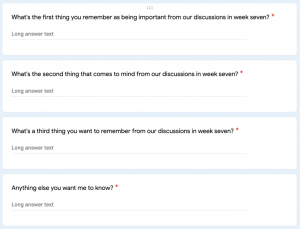2
Back in the Before Times, I wrote a blog post about ungrading, and how it had made an enormous difference in the experience of grading for both my students and myself. Grading went from being a chore to being a delight, and I thought I had found The Way (tip o’ the hat to The Mandalorian) from which I would only deviate if I could improve upon it.
Ha!
Enter the pandemic.
Where once I had every student come into my office to collaboratively decide on the grades attached to their major assignments, it proved impossible for me to that this term. I could have held some version of that conversation over Zoom, but I’ll be frank – the idea of spending that many hours on Zoom over a period of days felt horrifying. (If you’re someone who’s managed that, you have my sincere admiration!) Regular instruction also took much more time than usual, not because of the switch to online teaching, but because my students and I were all feeling the effects of executive dysfunction and other symptoms of trauma from the pandemic and all its associated losses. I plain did not have the time or energy to collaborate in the same way I had in person. But I was still committed to the umbrella practice of ungrading and all the benefits I knew it could bring to teaching and learning.
So I instituted two short-answer sets of questions to which my students responded each week. The first was due every Monday, and asked them to engage in retrieval practice by telling me three things they remembered as being important from the week before. (There was also an extra space for them to free-write on anything else they wanted me to know.) The second was due the morning of our once-weekly Zoom session, and asked them to reflect on the week’s readings by telling me what new things they learned, what we should talk about that week, whether they were confused by anything, and whether they had anything else they wanted to share. I also asked them to tell me how much of the reading they’d done – not to get them into trouble or to judge them, but to help me plan for class.

Both of these sets of questions were ungraded, and yet everyone consistently, diligently filled them in. This allowed me to identify and email students who were having difficulty getting work done, didn’t understand some of the concepts in our reading, or were struggling for any other number of reasons. I also got to share in their delight as they discovered new information about the past. I got to take their questions and use them to shape our discussions so that they not only got answers to their queries, but were co-creators of each class session. It meant there was a constant flow of information back and forth between my students and myself, and set up a relationship in which graded assignments were not the primary method of communication.
I know these students perhaps better than any I have ever had. And I think they probably know me better too, warts and all. It’s been a joyful way to assess how my students are doing and how the class is working. And all it has unfolded without a grade.

